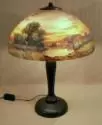Handel Lamps and the Arts & Crafts Style

The opulence of the Victorian aesthetic gave way to the organic influence of the Art Nouveau movement. At the same time, Gustav Stickley and the Arts & Crafts movement also began to take hold. More than just a movement with social implications, it produced a decorative style that often included the organic designs of the Art Nouveau, but in a much more refined and restrained aesthetic that, in Gustav Stickley ideology, complimented a more simple, honest lifestyle.
Many companies producing home furnishings during this time recognized the emerging Arts & Crafts style and began to include it in their design lines. Through the lamps of the Handel Company of Meriden, Connecticut, we can see a firm that embraced the movement’s designs in many of their decorative lamps.
The Handel Company was created in 1885 by Philip J. Handel. His vision was to produce hand-painted glassware and lighting. The successful venture grew to include what we now more commonly recognize as the Handel Company’s hand-painted lamps (top) and metal-overlay lamps (lower, click for enlargement), as well as a small line of leaded opalescent glass lamps.
The company’s strongest success occurred in the years between 1910 and 1920. The Great Depression took its toll on the company, but it survived and continued into the 1930s. Business declined heavily in the 1930s, however, and the company officially closed in 1936.
Although the Handel facility was what one might call a factory, much like that of Stickley, Bradley and Hubbard, and Tiffany Studios, it produced beautiful Arts & Crafts hand-created works of art, as evidenced by their painted lamps depicting landscapes and natural floral arrangements. It was a long and painstaking endeavor to produce these painted lamps. They required the hand of talented artists and many kiln firings to attain a finished product. Handel recognized the talent of his artists and in many cases had them sign their painted lamps, unlike most other firms.
Many, if not most, of the company’s metal-overlay lamps had strong Arts & Crafts designs that today’s collectors find compliment the furniture of Gustav Stickley and wonderful potteries of Grueby, Marblehead, Rookwood and others.
Collecting Handel lighting today is not an extremely difficult task. One can find them at antique shows, shops and auctions with some frequency and with reasonable prices when compared to the lamps of Tiffany Studios and other competitors of the period. As in all collecting categories, finding the more desirable examples is a little more daunting. When you recognize how important condition plays in value, it becomes even more difficult.
When considering painted Handel lamps, any chips, cracks and paint loss depreciate the value tremendously. In the case of metal-overlays, having the original glass panels and metal patina are vital in establishing value. The delicate nature of the metal-overlay construction makes it difficult to find undamaged, original examples today.
As in any collecting category, it is important to learn what to look for in order to make smart investments. Detecting condition problems or restorations, as well as developing an eye for the better designs, will bring visual enjoyment for years and will give you even better return on your investment in the future.
– Submitted by Jack Papadinis
Jack Papadinis specializes in antique lighting, art pottery and art glass from the Art Nouveau and Arts & Crafts periods. He will be exhibiting at the National Arts & Crafts Conference at the Grove Park Inn in Asheville, NC February 19-21, 2016.

